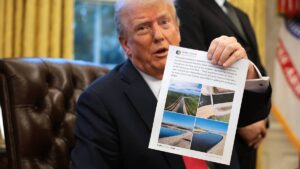Monsters of Rock: US manganese grants coming out the wazoo

Pic: Getty Images
- US Department of Energy splashes the cash on Aussie manganese miners
- BHP takes a look at Botswana copper
- Microsoft nuclear push sends yellowcake stocks radioactive
Aussie companies aiming to launch into the battery metals marketplace in the West have been given a shot in the arm from the dying embers of the Biden Administration.
South32 (ASX:S32) and Element 25 (ASX:E25) have secured grants for separate high purity manganese sulphate (HPMSM) projects in the United States, in an attempt from the US Government to eat into the supremacy of China in the battery supply chain.
Under 2% of the end market for manganese, largely used to harden steel, is in the lithium-ion battery space, where it is a part of the cathode in nickel-cobalt-manganese batteries and new generation lithium-iron-manganese-phosphate chemistries.
However, Benchmark Mineral Intelligence projected last year that battery demand could lift 8x by 2030, with next generation lithium-manganese nickel oxide chemistries potentially claiming a 6% share of the EV and energy storage battery market.
The growing use of the relatively abundant metal in batteries raises yet more alarm bells over how beholden the market is to China, which alongside its dominance in cell making, cathode production, lithium chemical and graphite refining, also controls 96% of HPMSM supply.
South32 announced today that its Hermosa project in Arizona, where it is building the US$2.2bn Taylor zinc mine, was the recipient of a US$166m grant for the project’s manganese dominant Clark deposit.
Battery play
S32 is already a major producer of manganese via its high-grade GEMCO JV (60-40 shared with Anglo American) in the Northern Territory, though its been temporarily shut for maintenance after the mine and its port were ripped through by a cyclone this year. It also owns mines in South Africa.
But it is not directly involved in the battery grade market yet. The grant from the DOE’s Battery Materials Processing and Battery Manufacturing program would, subject to final negotiation, fund 30% of the cost of a manganese production facility up to US$166m ($243m).
S32 said it was engaging potential customers to advance product qualifications for battery manufacturing.
A separate US$20m grant from the US Department of Defense is already being applied to help develop an underground decline, with access scheduled for the end of 2025.
“We welcome this grant from the US Department of Energy, which recognises Clark’s potential to supply battery-grade manganese to the emerging North American market,” S32 CEO Graham Kerr said.
“Hermosa represents a regional scale project with the potential to produce commodities critical to a low-carbon future across multiple deposits for decades to come.
“Following final investment approval earlier in the year, construction of our large-scale, long-life Taylor zinc-lead-silver project is progressing as planned.
“Our investment in Taylor will unlock value for future growth options, including Clark, by establishing significant shared infrastructure.
“In addition to Taylor and Clark, we are continuing further exploration programs at Peake to test the potential for a continuous copper system connecting Peake and Taylor.”
It’s all part of a US$3bn cash splash ahead of the US Election between Biden’s VP Kamala Harris and TV celeb turned Republican ex-Prez Donald Trump.
Part of the second round of a program that previously committed cash to ASX-listed Novonix (ASX:NVX) and Rio Tinto backed Talon Nickel, the US Government will also cost share to the tune of US$166m on a 71,650tpa HPMSM facility being planned for Louisiana by ASX minnow Element 25, in a project backed by carmaking customers Stellantis and General Motors.
The project is slated to create 400 jobs in construction and 144 during operations, creating a direct link between WA and the States by shipping ore from E25’s Butcherbird mine to the plant, slated to open in 2026.
Element 25 remains in a trading halt, but indicative price change from bids on the Commsec platform suggest the market is expecting a big move once the pause is lifted.
E25 previously announced a non-binding MoU to look into a facility also in Chiba with Japan’s Nissan.
BHP: The B stands for Botswana
BHP (ASX:BHP) could make a move into the hot Kalahari copper belt, home of some of the world’s top copper deposits with a little known Aussie junior.
Cobre (ASX:CBE) shares rose higher as it announced a deal to deal with BHP, declaring it was in exclusive negotiations for an earn-in joint venture of its Kitlanya West and East copper projects.
It seems like the contact was made via the BHP Xplor incubator program, which saw BHP provide funding for a seismic survey.
Cobre will keep 100% ownership of its Ngami and Okavango copper projects regardless of what deal is struck.
“Successful negotiation and completion of this significant transaction with BHP, one of the world’s leading mining companies, will be a major moment in time for Cobre as a company,” CBE CEO Adam Wooldridge said.
“Participating in the BHP 2024 Xplor cohort has provided the opportunity to do a belt scale review of the Kalahari Copper Belt, culminating with the collection of seismic data over the prospective northern margin of the belt.
“The proposed transaction with BHP would allow usto fully fund our follow-on exploration programmes and focus on discovering the Tier 1 deposits we believe may be hosted in our Kitlanya West and East Projects.
“Independently, Cobre will continue advancing its 100% owned in-situ copper recovery development at Ngami – with a scoping study due in early October – along with further drilling at Cobre’s 100% owned Okavango project.”
Home to Sandfire’s Motheo, the Chinese owned Khoemacau and Robert Friedland’s Kamoa-Kakula mine in Botswana and the DRC, as well as giant projects in Zambia like Barrick’s Lumwana, the Kalahari sedimentary copper belt has become the largest producing region of the red metal outside South America.
Materials closed down 0.67% today, with BHP’s 1.31% drop a big contributor, with iron ore in Singapore down 1.55% to US$90.25/t.
The second unit of the plant was the site of a highly-publicised meltdown in 1979, shortly after opening, though the first unit was operating until September 2019.
Making gains
Ora Banda (ASX:OBM) (gold) +9.5%
Boss Energy (ASX:BOE) (uranium) +8.2%
Deep Yellow (ASX:DYL) (uranium) +5.1%
Paladin Energy (ASX:PDN) (uranium) +4.7%
Eating losses
Aurelia Metals (ASX:AMI) (gold/copper/zinc) -5.7%
AIC Mines (ASX:A1M) (copper) -4.5%
Alkane Resources (ASX:ALK) (gold) -3.4%
Bellevue Gold (ASX:BGL) (gold) -3.1%
This article does not constitute financial product advice. You should consider obtaining independent advice before making any financial decisions.

UNLOCK INSIGHTS
Discover the untold stories of emerging ASX stocks.
Daily news and expert analysis, it's free to subscribe.
By proceeding, you confirm you understand that we handle personal information in accordance with our Privacy Policy.








